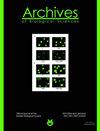拟除虫菊酯类杀虫剂-氟戊酸对非靶生物野鼠的致死和亚致死效应:急性毒性、遗传毒性和运动活性的研究
IF 0.8
4区 生物学
Q4 BIOLOGY
引用次数: 0
摘要
水生生态系统是包括杀虫剂在内的各种污染物的接受者。多年来,拟除虫菊酯类杀虫剂(如甲氟戊酸)已广泛用于农业活动中防治害虫。然而,它们不仅可以影响目标生物,也可以影响非目标生物。本研究旨在探讨tau-氟valinate对非靶生物Gammarus roeseli的致死和亚致死作用。为此,使用96小时暴露期的毒性试验确定了tau-氟戊酸的急性毒性,并使用彗星试验在24、96和240小时暴露期评估了不同亚致死浓度对试验生物体血细胞的遗传毒性影响。在120和240小时的时间内,对暴露于亚致死浓度的试验生物的运动活动的变化进行了评估。96 h中位致死浓度(LC50)为17.29 g/L,在测试的亚致死浓度(2.15、4.30和8.60 g/L)下,tau-氟戊酸可导致DNA损伤显著增加,运动活性显著降低。这项研究的结果表明,在水生环境中长期存在高浓度的甲氟戊酸对非目标生物是一个值得注意的威胁,应重新考虑其在农业活动中的使用。本文章由计算机程序翻译,如有差异,请以英文原文为准。
Lethal and sublethal effects of the pyrethroid insecticide tau-fluvalinate on the non-target organism Gammarus roeseli: A study of acute toxicity, genotoxicity and locomotor activity
Aquatic ecosystems are recipients of various contaminants including pesticides. For many years, pyrethroid insecticides (e.g., tau-fluvalinate) have been used extensively in agricultural activities to control pests. However, they can affect not only target organisms but also non-target organisms. This study was conducted to investigate the lethal and sublethal effects of tau-fluvalinate on the non-target organism Gammarus roeseli. To this end, acute toxicity of tau-fluvalinate was determined using a toxicity test with a 96-h exposure period, and the genotoxic effects of different sublethal concentrations on hemocytes of the test organism were assessed at 24-, 96-, and 240-h exposure periods using the comet assay. Alterations in locomotor activity of the test organism in response to exposure to sublethal concentrations were evaluated at 120- and 240-h periods. The 96-h median lethal concentration (LC50) was found to be 17.29 ?g/L, and tau-fluvalinate was observed to cause a significant increase in DNA damage and a significant reduction in locomotor activity at the tested sublethal concentrations (2.15, 4.30 and 8.60 ?g/L). The results of this study suggest that the long-term existence of tau-fluvalinate in aquatic environments at high concentrations is a noteworthy threat to non-target organisms and that its use in agricultural activities should be reconsidered.
求助全文
通过发布文献求助,成功后即可免费获取论文全文。
去求助
来源期刊
CiteScore
1.40
自引率
0.00%
发文量
25
审稿时长
3-8 weeks
期刊介绍:
The Archives of Biological Sciences is a multidisciplinary journal that covers original research in a wide range of subjects in life science, including biology, ecology, human biology and biomedical research.
The Archives of Biological Sciences features articles in genetics, botany and zoology (including higher and lower terrestrial and aquatic plants and animals, prokaryote biology, algology, mycology, entomology, etc.); biological systematics; evolution; biochemistry, molecular and cell biology, including all aspects of normal cell functioning, from embryonic to differentiated tissues and in different pathological states; physiology, including chronobiology, thermal biology, cryobiology; radiobiology; neurobiology; immunology, including human immunology; human biology, including the biological basis of specific human pathologies and disease management.

 求助内容:
求助内容: 应助结果提醒方式:
应助结果提醒方式:


